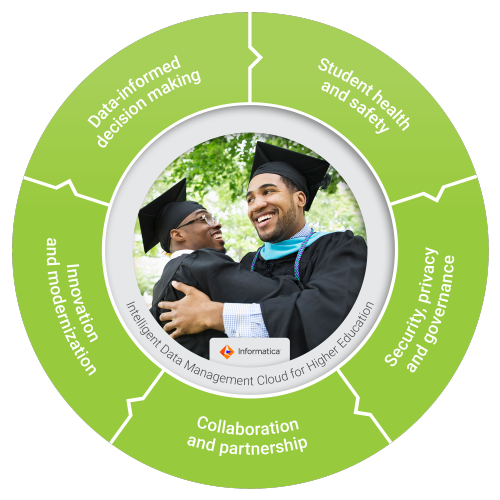Drive Collaboration and Better Engage Students with the Informatica Intelligent Data Management Cloud for Higher Education

Five strong business drivers are rapidly changing the way higher education institutions boost internal efficiency and help ensure optimal student experiences. All of these drivers share a common thread: to capitalize on them, you need to leverage the value of data at scale. Universities and colleges that make modern data management and data analytics a top priority will thrive in the future. Those that return to the pre-pandemic environment of siloed data will be challenged to stay relevant and solvent.
Creating value from data in higher education can result in transformative student recruitment and retention and alumni engagement. A solid data management framework can positively impact student experiences and interaction. It can enhance faculty collaboration and improve administrative operations — this is especially important for financial efficiencies. Leveraging data for strategic decisions can also deliver more personalized educational experiences.
The time to act is now. The future of higher education is data driven. To help you meet these drivers of change, Informatica is launching the Intelligent Data Management Cloud (IDMC) for Higher Education.
The Five Big Drivers of Change … and the Impeding Data Challenges

1. Collaborating and partnering across departments, schools and student activities is no longer a luxury. They are crucial imperatives for sharing information to achieve timely and impactful interdisciplinary outcomes. Reducing the stove-pipe data environment common in many institutions mitigates unnecessary duplicity. It also eliminates data confusion.
This can help improve services for students, faculty and researchers, and administrators. It can also positively impact effective resourcing — budgetary and human-centered. Access to clean and complete data is an essential part of modernization, whether that data resides on-premises or in the cloud. Common data-sharing challenges to achieve seamless connections across entities can include:
- Siloed applications and lack of process integration
- Poor quality data impeding automation
- Repetitive manual workflows
2. Innovation and modernization with trusted data drives growth. Better managed, high-quality data and AI- powered data analytics can lead to more personalized student services and digitally transformative approaches to education. Students expect their higher education experience to reflect the same level of technology they’ve grown up with. This means it must be on demand, easy and intuitive to use and a one-stop shop for all administrative interactions.
Data challenges here include:
- The burden of upgrading older, legacy student information systems
- A lack of integration with frontline software such as a learning management system (LMS) and Salesforce
- Incomplete reporting on data quality and outcomes
3. Senior leaders are operationalizing data-informed decision-making to chart their institution’s future success. This is not a new trend in higher education. The ability to enhance this concept in a timely manner is — and it continues to grow as technology matures. Integrated data necessary for accurate analysis can reduce the risk of suboptimal investments. These investments may include housing and facilities, course curriculums, faculty hiring, student services and other key business functions.
Experiential or intuition-based decision-making is beneficial. However, results from a study conducted by a group of researchers from MIT and The University of Pennsylvania’s Wharton School of Business show that when combining experiential and data-driven decision making, productivity increases by at least 5%.1
Higher education can leverage what technology has to offer for better decision-making. To do this, they must look for solutions that:
- Reduce inaccurate student profiles that prevent a 360-degree view of student information
- Eliminate poor data quality that can create barriers to accurate analytics
- Address data sources, including third-party data
4. The global pandemic shifted more responsibility for student health and safety to institutions. This means more and better on-campus data collection, monitoring and analysis. For schools within large cities, decisions require close collaboration with community health authorities. This could be anything from school closures to masking, testing, supplies and more.
To ensure they can respond ably to crisis situations, schools have recognized a need for data platforms with trusted and complete information. As a best practice and lesson learned, schools are ensuring they have the capability to manage data better for both future crises as well as systemic student body health issues. As with other drivers, success in campus health readiness depends on addressing similar data challenges. These include:
- Cleaning up duplicate and incomplete student and campus profiles
- Establishing reliable sources of reference data
- Eliminating manual data quality efforts that slow down response and pre-emptive actions
- The inability to share and sync data between applications used across campus
5. Meeting security, privacy and compliance policies and regulations is vital for higher education. Data leaks and breaches of student and faculty information can lead to serious repercussions. These may damage the bottom line and take significant time to remediate. Anonymizing and protecting sensitive data, while ensuring that data remains available to users based on their roles, responsibilities, and needs, is a delicate balancing act.
Challenges in meeting this change-driver include:
- Duplicate and incomplete student, faculty and administrative data
- Limited reliable sources of reference data; fragmented and poor-quality data across multiple sources
- Data locked within applications
- No established, automated flow of data across campus functions
Tackling the Data Challenges with the Informatica Intelligent Data Management Cloud for Higher Education
Informatica Intelligent Data Management Cloud™ (IDMC) for Higher Education delivers a portfolio of data management capabilities. The solution is designed specifically for colleges and universities seeking to modernize and thrive in the new environment created by the five big drivers of change. When considering choices for digital modernization to provide data insights and value across the many higher education use cases, capabilities should include:
- A unified view of data and insight across critical business domains with data integration and multi-domain master data management and 360 SaaS applications (e.g., student, faculty, alumni, constituent and more)
- Integration throughout external data, third-party data and applications such as Salesforce, Blackboard, Canvas, learning management systems (LMS) and more.
- The capability to automate and streamline business processes at scale with data and application integration and hyperautomation capabilities
- Prioritization of internal and external data sharing (seamless inter-departmental cross-registrations) with a centralized, self-service data marketplace
- Protection of student data and compliance facilitation for the California Consumer Privacy Act (CCPA), Family Educational Rights and Privacy Act (FERPA), HIPAA and other global, federal and state privacy regulations
- A consistent view of trusted data across business entities to reflect the complete student journey with data cataloging and governance
- The cleansing, standardization, enrichment and validation of data with out-of-the-box data quality rules
- Reduction in time to value with out-of-the-box data management accelerators (data quality accelerator, data management for crisis response, AI-powered automation and more)
Accelerating collaboration and innovation and a more personalized higher education experience through data modernization starts with leading edge data management capabilities. Colleges and universities have an opportunity to transform now to meet the demands that the five big drivers of change are forcing upon their industry. Institutions that grasp this opportunity will secure their future. They will be able to attract the students they want, retain them and gain the internal efficiencies needed in a competitive environment.
To find out more about IDMC for Higher Education, read our brochure, “Modernizing Higher Education for Connected Campus Experiences,” and check out our web page.
1http://ssrn.com/abstract=1819486



